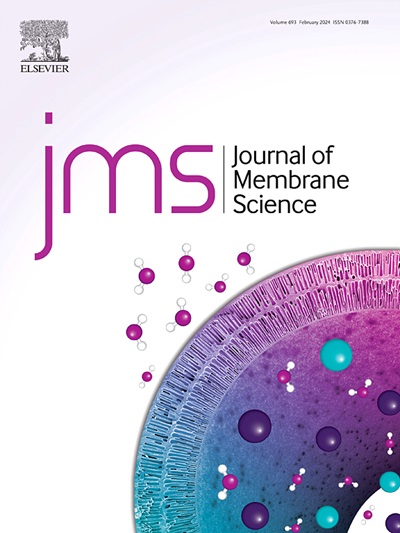嵌套娃娃启发双层纳滤膜,高效去除PFAS和自然水净化
IF 8.4
1区 工程技术
Q1 ENGINEERING, CHEMICAL
引用次数: 0
摘要
定制聚酰胺纳滤(NF)膜的表面褶皱形态允许有针对性地调节其性能,从而优化膜的功能,以适应不同的应用场景。这种方法已成为膜技术,特别是工业应用的关键研究方向。在本研究中,通过添加LiCl实现了聚合速率、分子扩散行为和界面反应动力学的精确调节。利用Li+与羰基配位的协同效应和界面热现象,成功设计了具有多个过滤界面的套套娃娃结构。这大大提高了纳滤膜的分离效率。因此,制备的纳滤膜在自然地表水处理中表现出显著的优势。具体来说,独特设计的巢娃娃膜(PIP - Li@3)对溶解有机碳和荧光有机物的去除率分别达到89.5%和95.9%。PIP-Li@3在处理复杂和难以去除的全氟烷基和多氟烷基物质方面表现出卓越的功效。与NF270相比,PIP-Li@3对不同分子量的PFAS表现出更好的去除性能,对全氟辛酸的去除率达到98.4%。本研究提出了一种绿色高效的方法,通过调节两段IP反应速率制备具有独特巢形娃娃形态的NF膜,从地表水中去除PFAS。本文章由计算机程序翻译,如有差异,请以英文原文为准。

Nesting doll-inspired double-layered nanofiltration membranes for highly efficient PFAS removal and natural water purification
Tailoring the surface pleat morphology of polyamide nanofiltration (NF) membranes allows for targeted modulation of their performance, thereby optimizing membrane functionality for diverse application scenarios. This approach has emerged as a critical research direction in membrane technology, particularly industrial applications. In this study, the precise modulation of the polymerization rate, molecular diffusion behavior, and interfacial reaction kinetics was achieved by adding LiCl. By leveraging the synergistic effects of Li+ coordination with carbonyl groups and the interfacial thermal phenomena, a nesting-doll structure featuring multiple filtration interfaces was successfully engineered. This significantly enhances the separation efficiency of NF membranes. Consequently, the prepared NF membranes exhibit notable advantages in natural surface water treatment. Specifically, the uniquely designed nesting-doll membrane (PIP–Li@3) achieved 89.5 % and 95.9 % removal rates for dissolved organic carbon and fluorescent organics, respectively. The PIP-Li@3 demonstrated exceptional efficacy in treating complex and difficult-to-remove per- and polyfluoroalkyl substances. Compared to NF270, the PIP-Li@3 exhibits superior removal performance for PFAS of varying molecular weights, achieving a rejection rate of 98.4 % for perfluorooctanoic acid. This work presents a green and efficient method for removing PFAS from surface water by preparing NF membranes with a unique nesting-doll morphology by regulating the two-stage IP reaction rate.
求助全文
通过发布文献求助,成功后即可免费获取论文全文。
去求助
来源期刊

Journal of Membrane Science
工程技术-高分子科学
CiteScore
17.10
自引率
17.90%
发文量
1031
审稿时长
2.5 months
期刊介绍:
The Journal of Membrane Science is a publication that focuses on membrane systems and is aimed at academic and industrial chemists, chemical engineers, materials scientists, and membranologists. It publishes original research and reviews on various aspects of membrane transport, membrane formation/structure, fouling, module/process design, and processes/applications. The journal primarily focuses on the structure, function, and performance of non-biological membranes but also includes papers that relate to biological membranes. The Journal of Membrane Science publishes Full Text Papers, State-of-the-Art Reviews, Letters to the Editor, and Perspectives.
 求助内容:
求助内容: 应助结果提醒方式:
应助结果提醒方式:


